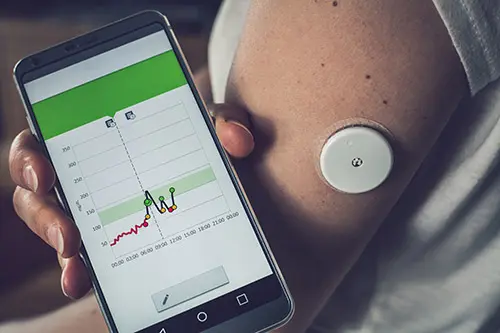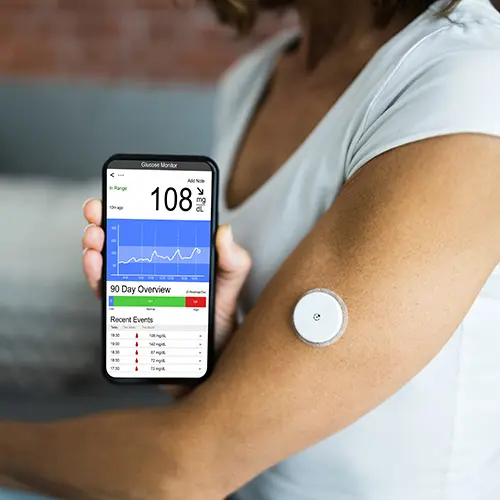What are blood sugar monitors and how do they work?
Published
Key Article Takeaways
- There are two types of blood sugar monitors: traditional finger-prick glucometers and continuous glucose monitors (CGMs).
- CGMs are newer, wearable devices that monitor your blood sugar in real time which is useful for both diabetics and non-diabetics.
- Finger-prick glucometers give you a single blood sugar reading and are very commonly used in hospitals and by diabetics.
A blood sugar monitor is a device that measures the amount of glucose (sugar) in your blood. This can be done in two main ways, using:
- A traditional finger-prick test with a strip and a small device called a glucometer, or
- A wearable device called a continuous glucose monitor (CGM).
Monitoring your blood sugar is important because it helps you understand how your body is handling your blood sugar. This is crucial for managing or preventing conditions such as diabetes. Learn more about blood sugar and what your levels mean.
However, even if you’re not diabetic, monitoring your blood sugar still offers you crucial insights into your metabolic health. Apart from telling you if you have pre-diabetes and are at risk of going on to develop diabetes, a continuous glucose monitor tells you more generally how your body is handling your blood sugar which has an impact on your risk of heart disease and cancer.
How do blood sugar monitors work?
When you eat, carbohydrates are broken down into glucose. This glucose circulates in your blood and is distributed to various tissues and organs in your body.
Blood sugar monitors measure the concentration of glucose in your blood (or in the fluid around your cells). Glucose is a key energy source for the body, and tracking its levels helps identify patterns related to food, activity, stress, or illness.
How does a continuous glucose monitor (CGM) work?
A CGM is a small device you wear on your skin, usually on your upper arm. It has a tiny sensor that sits just under the skin and continuously measures glucose levels in the fluid between your cells.
This data is sent to an app on your phone, giving you a real-time picture of your blood sugar trends. You can use this data to track highs and lows and see how your body responds to certain foods or activities. At Selph, we have a specific programme to help people get the most out of data from their CGM.
CGMs have a couple of major benefits compared to the traditional finger-prick tests. Firstly, they measure your blood sugar in real-time. This means they’re better at spotting blood sugar changes over time that you would miss with a finger-prick test taken at intervals. Secondly, they’re continuous, meaning that they work even while you’re asleep. Lastly, they’re painless to use whereas your fingers can get pretty sore with repeated pricks. The main downside of a CGM is the cost - each sensor is generally more expensive than a glucometer.
How does a finger prick blood sugar test work?
A finger prick test – also known as a capillary blood glucose test – uses a small lancet to prick your finger and draw a drop of blood. You apply this drop of blood to a test strip, which is then inserted into a small handheld device called a glucometer that gives you a blood sugar reading within seconds.
This method is affordable and widely used, especially among people with diabetes. It is also often used in hospitals, clinics, and by GPs. The main downside is that it only provides a snapshot of your blood sugar at a single moment. They can also be quite inconvenient or uncomfortable if done frequently.
How can I choose a good blood sugar monitor for me?
Choosing the right blood sugar monitor depends on your medical needs, lifestyle, and budget. For diabetics, the monitor you choose will depend on whether you take insulin and what fits your lifestyle best. For non-diabetics, looking to delve into their metabolic health, CGMs are usually the best option as we specifically want to see the changes in blood sugar over time with food and activity.
Finger prick tests have been the standard method for many years – they’re reliable and cost-effective but can feel uncomfortable if used often. They also require you to have supplies on hand and remember to check at regular intervals.
While more costly, CGMs offer a much more convenient and hands-off way to monitor blood sugar levels continuously. Studies have also shown that CGMs improve diabetes control in patients on insulin1. CGMs may be available from your NHS diabetes team, particularly if you have Type 1 diabetes or take insulin. However, there may be long wait times (sometimes up to 12 months) or limited access, depending on eligibility.
Take the Selph CGM
How your body is handling blood sugar is a key window into your metabolic health that you just can't any other way. At Selph, we provide a two-week programme where you you'll use a CGM to track your blood sugar levels in response to food and activity. You'll also do a glucose challenge where we monitor your bodies response to a 75g glucose load. Stressing your metabolism like this provides more insight than your day-to-day blood sugar fluctuations. We then analyse your data and give you a report with recommendations to improve your sugar-handling. You'll also discuss your results with one of our metabolic health experts so you really understand what you need to do to improve your metabolic health.
Get tips on better health
Sign up to our emails on the better way to better health.
We'll keep you up-to-date with the latest research, expert articles and new ways to get more years of better health.







